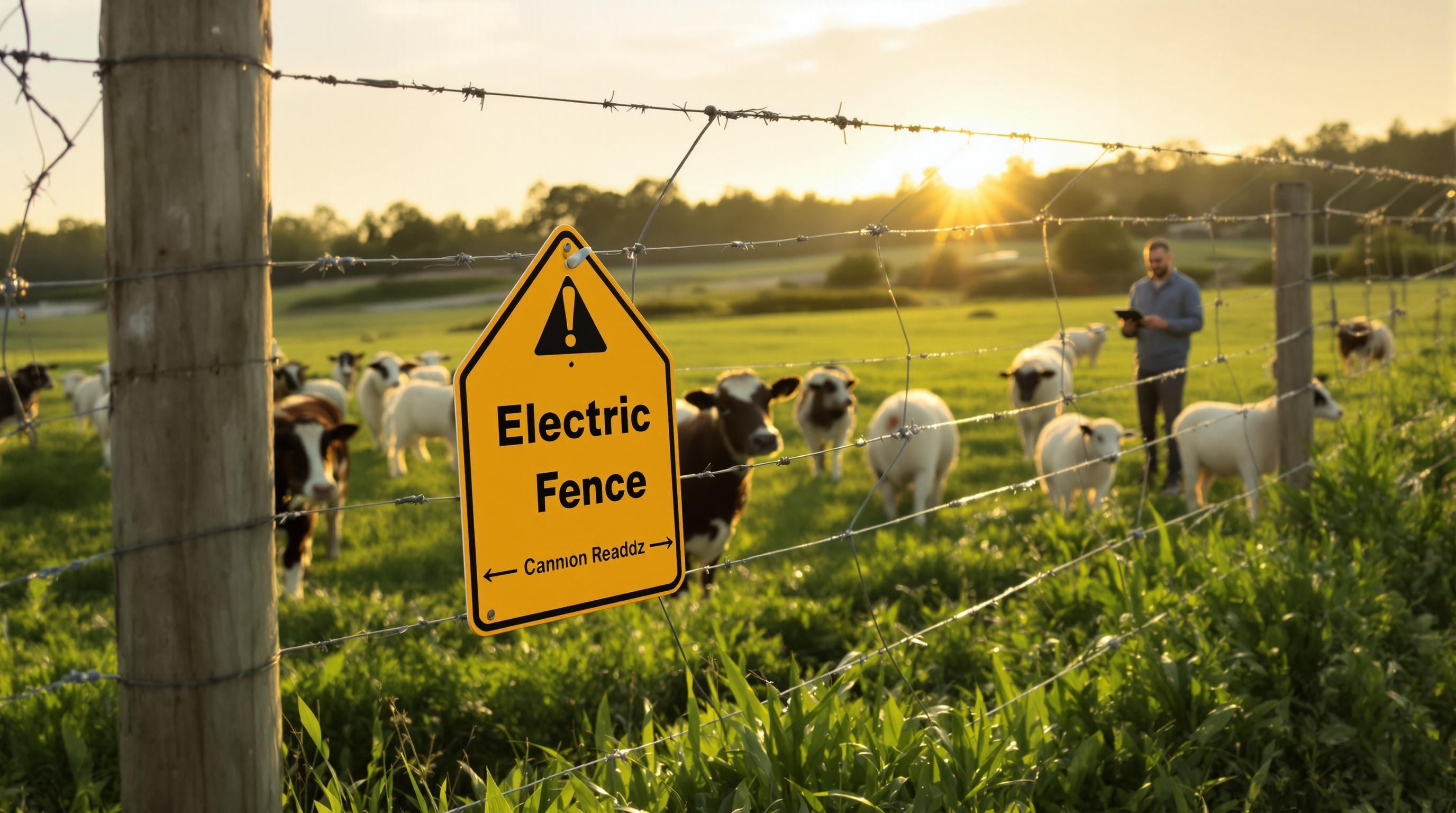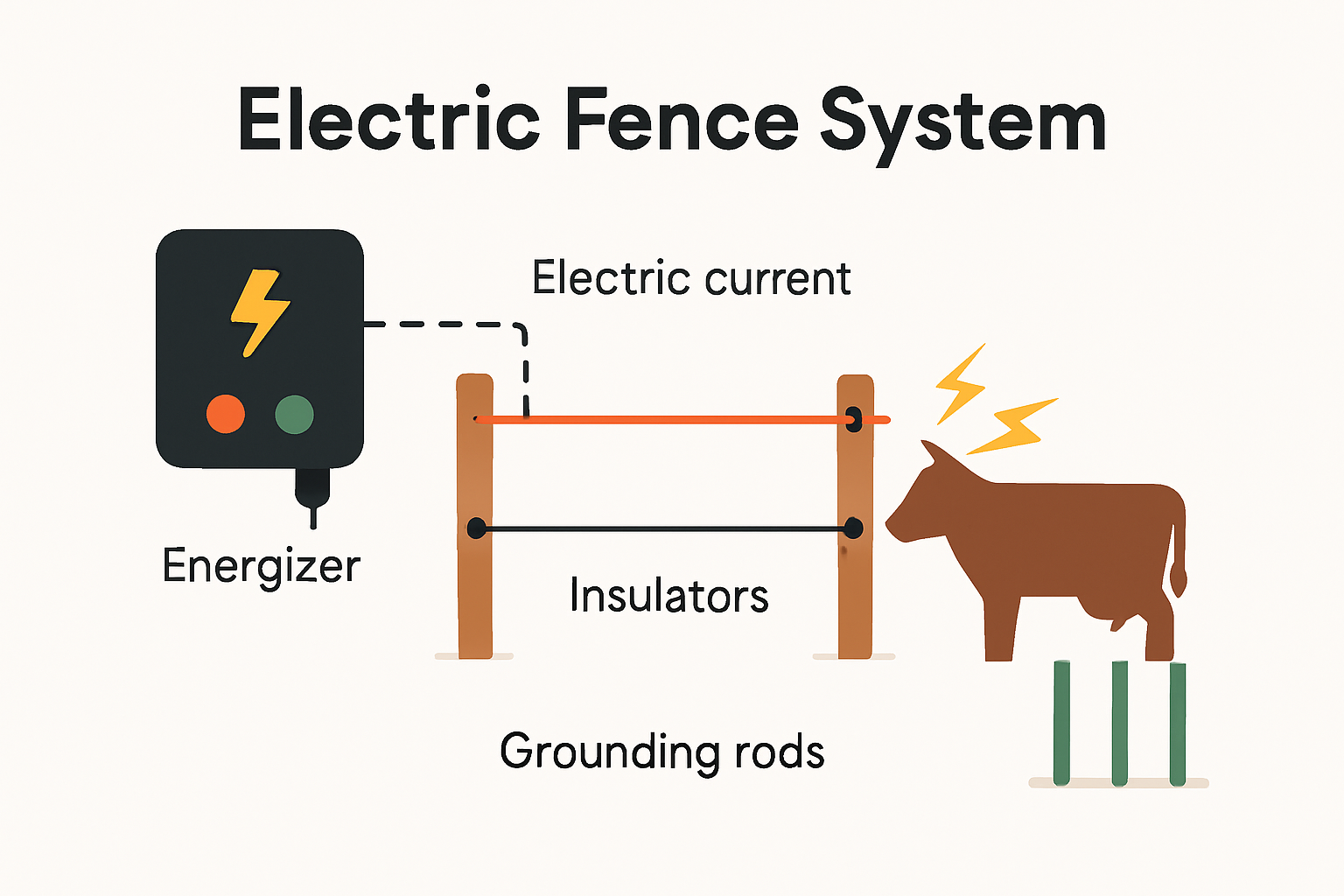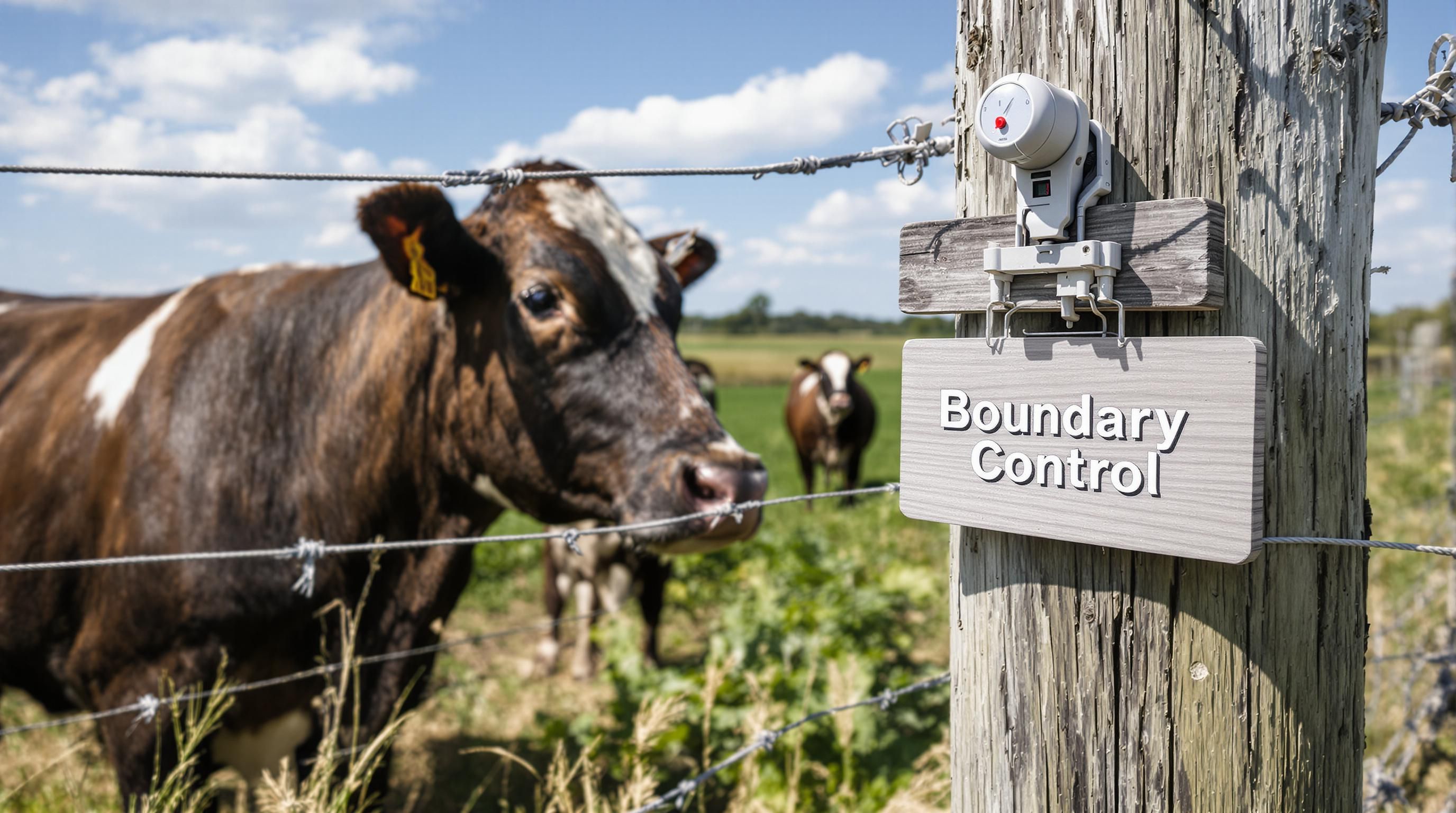
Electric fences are now found on over 60 percent of managed livestock farms across the US, thanks to their unique mix of precision and humane control. Most folks imagine a wall of constant shock or visual danger but the real magic happens when a fence becomes nearly invisible yet trains whole herds to respect a simple thin wire. Instead of relying on brute strength, these systems use just a zap of energy and a lesson that animals never forget.
Table of Contents
- Understanding Electric Fence Components
- How Electric Fences Control Livestock
- Installing and Maintaining Your Electric Fence
- Safety Tips and Best Practices for 2025
Quick Summary
| Takeaway | Explanation |
|---|---|
| Understand core components | Familiarizing yourself with the energizer, grounding system, and fence wire is essential for effective electric fence implementation. |
| Prioritize proper grounding | Effective grounding is crucial; inadequate grounding can compromise your fence’s performance and effectiveness in livestock control. |
| Conduct regular maintenance | Inspect the fence monthly for damage, vegetation, and voltage levels to ensure reliable operation and prevent livestock escapes. |
| Implement safety measures | Ensure the fence is visible and educate all users on safety protocols to prevent accidents and injuries around electric fences. |
| Adapt to animal behavior | Recognize that different livestock species require unique approaches to training for effective fence boundary compliance. |
Understanding Electric Fence Components
Electric fences represent a sophisticated system designed to control and protect livestock while maintaining property boundaries. Understanding the core components is crucial for anyone considering implementing an electric fencing solution.

The Core Electrical System
According to the University of Maine Cooperative Extension, an electric fence system consists of three fundamental components: the energizer, grounding system, and fence design. Each plays a critical role in creating an effective barrier.
The energizer serves as the heart of the electric fence system. It generates high-voltage electrical pulses that travel through the fence wire. Virginia Tech’s agricultural publication explains that these pulses are characterized by high voltage but low amperage, which ensures an animal receives a sharp but safe deterrent shock.
To clarify the core components and their functions, the table below provides a summary:
| Component | Function | Key Points |
|---|---|---|
| Energizer | Generates high-voltage, low-amperage pulses for the fence | Heart of system; provides safe yet noticeable shock |
| Grounding System | Completes the circuit when animal touches the wire | Effectiveness depends on proper implementation |
| Fence Wire | Conducts electrical pulses along the fence line | Material selection based on livestock and terrain |
| Insulators | Prevents current from leaking into posts or ground | Essential for maintaining current in the wire |
Grounding and Circuit Completion
The grounding system acts as an essential conductor in the electrical circuit. When an animal touches the electrified wire, electrons flow through the animal’s body into the ground, completing the circuit back to the energizer. Proper grounding determines the effectiveness of the entire system.
Read our guide on selecting the right ground stakes for ensuring optimal electric fence performance. Inadequate grounding can result in inconsistent shock delivery and reduced fence effectiveness.
Fence Wire and Insulators
The physical components of an electric fence include specialized wire, insulators, and support posts. Insulators prevent electrical current from escaping into supporting structures, ensuring the current remains concentrated in the fence wire. Wire materials vary depending on specific agricultural needs, ranging from steel-based options for high-tension applications to polymer-based wires for more flexible installations.
Choosing the right combination of components requires understanding your specific livestock management requirements. Factors like animal type, terrain, and potential predation risks will influence your electric fence design and component selection.
Electric fences offer a dynamic solution for livestock management, providing a psychological and physical barrier that is both effective and humane when properly implemented.
How Electric Fences Control Livestock
Electric fences provide a sophisticated psychological and physical barrier for managing livestock, leveraging an animal’s natural behavioral responses to electrical stimulation. Understanding how these fences effectively control animal movement requires examining their sensory and neurological impact.
Psychological Deterrence Mechanism

When an animal contacts an electrified fence, it experiences an immediate and uncomfortable electrical pulse. This sensation creates a powerful learned response that prevents future attempts to breach the boundary. Research from Kansas State University Agricultural Experiment Station indicates that animals quickly develop a conditioned avoidance response after just one or two brief encounters with an electric fence.
The shock delivered is designed to be startling yet safe. The high-voltage, low-amperage pulse creates an intense but brief sensation that triggers an immediate retreat response without causing long-term physical harm. This makes electric fencing a humane method of livestock control that relies on psychological conditioning rather than physical restraint.
Behavioral Adaptation and Learning
Texas A&M AgriLife Extension explains that different animal species respond uniquely to electric fencing. Cattle, for instance, learn quickly and will typically avoid the fence after a single encounter. Sheep and goats may require multiple exposures to develop a consistent avoidance behavior.
To help compare how various species adapt to electric fences, the table below summarizes behavioral responses:
| Livestock Species | Typical Learning Response | Training Required |
|---|---|---|
| Cattle | Quick—often after one encounter | Minimal |
| Sheep | Moderate—several exposures | Moderate |
| Goats | Slower—multiple exposures | More intensive |
| Horses | Quick—responds well | Minimal |
| Pigs | Moderate to quick | Some initial training |
Learn more about advanced livestock management techniques that complement electric fencing strategies. The effectiveness of these systems depends not just on the electrical pulse but on consistent and strategic fence placement.
Precision Boundary Management
Electric fences offer unprecedented precision in livestock control. Unlike traditional physical barriers, they can be easily reconfigured to create rotational grazing systems, protect specific areas, or manage herd movement with minimal infrastructure. The psychological barrier created by electric fencing allows farmers to dynamically manage pasture usage, preventing overgrazing and promoting more sustainable land management.
The shock mechanism works by creating a clear, memorable consequence for boundary crossing. Animals quickly learn that certain areas are off-limits, reducing the need for constant physical supervision. This makes electric fencing an intelligent solution for large pastures and diverse agricultural environments where traditional fencing proves impractical or cost-prohibitive.
By combining psychological deterrence with minimal physical intervention, electric fences represent a modern, efficient approach to livestock management that prioritizes both animal welfare and agricultural productivity.
Installing and Maintaining Your Electric Fence
Successful electric fence implementation requires careful planning, precise installation, and consistent maintenance. Proper setup ensures the fence remains an effective livestock management tool that provides reliable protection and boundary control.
Preparation and Initial Installation
Virginia Tech’s agricultural extension recommends using 12 ½ gauge high-tensile smooth wire with a Class 3 galvanized coating for durability. Quality matters when selecting materials. Use high-grade wire clamps or crimps for all wire connections and invest in quality insulators to prevent current leakage.
When planning your fence layout, consider terrain, livestock type, and potential challenges. Straight lines and minimal obstacles will improve electrical conductivity and reduce maintenance requirements. Mark your proposed fence line carefully, ensuring minimal interference from vegetation or ground irregularities.
Grounding System Implementation
The grounding system represents the most critical component of your electric fence. Mississippi State University Extension emphasizes that inadequate grounding is the most common failure point in electric fencing systems. Install ground rods in areas with consistent moisture, typically at least 6-8 feet deep, and space multiple rods 10 feet apart for optimal conductivity.
Explore our professional ground stake solutions to ensure reliable electrical circuit completion. Test your grounding system regularly using a dedicated ground resistance tester to verify consistent performance.
Ongoing Maintenance and Troubleshooting
Regular inspection is crucial for maintaining electric fence effectiveness. Walk your fence line monthly, checking for damaged insulators, broken wires, vegetation growth, and potential short circuits. Clean vegetation that contacts the fence wire, as plant material can drain electrical current and reduce system performance.
Periodically test voltage levels using a reliable voltmeter. A properly functioning electric fence should maintain between 4000-5000 volts. Lower readings indicate potential grounding issues, wire damage, or system component failure. Replace worn components immediately to prevent livestock escape or predator intrusion.
Consider seasonal variations in your maintenance approach. Winter conditions may require additional insulation and more frequent checks, while summer vegetation growth demands more aggressive trimming. Develop a comprehensive maintenance schedule tailored to your specific environmental conditions and livestock management needs.
A well-designed and maintained electric fence offers more than just a physical barrier. It provides a sophisticated, psychological containment system that protects your livestock while offering flexibility in pasture management. Invest time in proper installation and consistent maintenance to maximize your electric fencing investment.
Safety Tips and Best Practices for 2025
Electric fencing requires meticulous attention to safety protocols to protect both humans and animals. Understanding and implementing comprehensive safety measures ensures effective livestock management while minimizing potential risks.
Personal Safety Precautions
Texas A&M AgriLife Extension Service provides critical guidance on personal safety around electric fences. Avoid touching electrified wires with your head, neck, or spine. Never attempt to step over or climb through an electrified fence, as this can result in serious injury.
Make the fence highly visible by using bright markers or warning signs. Explore our safety signage solutions to enhance fence visibility and prevent accidental contact. Educate all farm personnel and family members about electric fence safety, ensuring everyone understands the potential risks and proper interaction protocols.
Installation and Equipment Safety
Virginia Tech’s agricultural publication recommends using specialized equipment to maximize safety. Avoid using copper components, which can degrade quickly. Instead, opt for 12.5-gauge high-tensile smooth wire with a Class 3 galvanized coating. Use insulated lead-out cables specifically designed for electric fencing to prevent electrical hazards.
Install a lightning diverter to protect your energizer from electrical surges. The Manitoba Agriculture guide emphasizes the importance of proper grounding, recommending a minimum of three 6-8 foot ground rods spaced at least 3 meters apart. This configuration helps dissipate electrical charge and reduces the risk of equipment damage.
Animal and Environmental Considerations
Prioritize animal welfare by avoiding potentially dangerous fence configurations. Do not electrify barbed wire, as this can cause serious injury to livestock and wildlife. Regularly inspect fence lines to remove potential hazards like fallen branches, overgrown vegetation, or damaged components that could compromise safety.
Consider the specific needs of different animal species. Young or unfamiliar animals may require additional visual barriers or gentler initial exposure to electric fencing. Implement a gradual training approach that allows animals to learn and respect fence boundaries without unnecessary stress.
As agricultural technology evolves, electric fencing continues to offer a sophisticated solution for livestock management. By prioritizing safety, maintaining equipment, and understanding potential risks, farmers can create effective and secure boundary systems that protect both their animals and property.
Remember that safety is an ongoing process. Regular training, equipment maintenance, and a proactive approach to potential hazards will ensure your electric fencing remains a reliable and safe livestock management tool.
Frequently Asked Questions
How does an electric fence work?
An electric fence works by delivering a brief, high-voltage electrical pulse through the fence wire when an animal touches it. This pulse creates a psychological deterrent that trains animals to avoid the boundary.
What are the key components of an electric fence?
The key components of an electric fence include the energizer (which generates the electrical pulses), the grounding system (which completes the circuit), and the fence wire (which conducts the pulses along the fence line).
How do I install an electric fence?
To install an electric fence, plan the layout considering terrain and livestock type, then set up the energizer, grounding system, and fence wire. Use appropriate materials and follow safety guidelines for installation.
What maintenance is needed for an electric fence?
Regular maintenance includes inspecting the fence for damage, checking voltage levels, clearing vegetation that may block the current, and testing the grounding system to ensure reliable operation.
Take Control of Livestock Fencing With Solutions That Work
Still worrying about inconsistent shocks, unpredictable animal escapes, or the hassle of maintaining your electric fence? This guide explained how crucial the energizer, grounding, fence wire, and smart design are for success. If you want fewer escape attempts, safer boundaries, and healthier livestock, your fencing equipment must be reliable and tailored for your unique challenges.

Choose accuracy and peace of mind. Visit FenceFast.ca to explore trusted electric fencing supplies designed for farms just like yours, from energizers and ground stakes to insulators and expert advice. Need grounding that actually works? Check out our quality ground stake solutions to prevent frustrating power loss. Ready to upgrade, start a new installation, or troubleshoot persistent issues? Shop now or connect with our team for fast support and easy online ordering. Make your next fencing project stronger and safer today.
Recommended
-
[
Gallagher Earth Ground Stake KIWITAH – FenceFast Ltd.
](https://fencefast.ca/products/gallagher-kiwitah-ground-stake)
-
[
200 WATTS 12 VOLTS MONOCRYSTALLINE SOLAR BUNDLE KITS – FenceFast Ltd.
](https://fencefast.ca/products/200-watts-12-volts-monocrystalline-solar-bundle-kits)
-
[
Gallagher Vine-Line Wire Connector – FenceFast Ltd.
](https://fencefast.ca/products/gallagher-vine-line-wire-connector)
-
[
Gallagher Turbo Wire 2.5mm – FenceFast Ltd.
